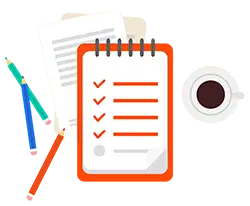Learn how to write an effective cover letter with proper formatting, formal language, structure, and key sections that boost job application success.
Introduction
A cover letter accompanies a CV and is written in a personal capacity to seek employment. It gives an overview of all relevant skills, qualifications, and interests concerning this job and argues why you are the best candidate for the position.
It aptly complements your resume by presenting your personality about specific job requirements and establishing how your experience aligns with the company's prevailing requirements. Thus, it increases your chances of obtaining an interview.
Types of Cover Letters
There are many types of covering letters, each having its particular function in job applications. Here are some of the general things one commonly uses:
Application Cover Letter
It is the most common type to accompany the resume for a particular job. You mention your key skills, experience, and eagerness on the one hand and, on the other hand, state why you are a strong candidate for this.
Prospecting Cover Letter
An inquiry letter expresses interest in possible job openings in a company. This introduction letter outlines your qualifications and asks if any opportunities interest you.
Networking Cover Letter
The cover letter for job opportunities through professional contacts is sent out via former colleagues, mentors, or industry professionals. It solicits job leads, referrals, or career advice.
Referral Cover Letter
This type of letter mentions a mutual contact who has referred you to the job. A reference from someone inside the organisation will work to your advantage.
Career Change Cover Letter
This type of letter explains the change you are making in the career field. if you are making a shift from one industry to another. It carries information about your transferable skills and demonstrates how your background fits with the new role.
How to Structure a Cover Letter?
There are key sections to consider under an effective cover letter that complements your application to make a lasting impression:
Header
Your name, address, and phone number must include your email address; below that, add the name, title, company name, and address of the hiring manager to maintain a professional format.
Formal Greeting
If you can use their name, address the hiring manager personally. In case you do not know their name, you may use "Dear Hiring Manager," which keeps it formal and respectful.
Introduction
State the title for which you are applying and where you found it in the job advert. Also, give a brief reason for your excitement and how your persuasive skills align with the position.
Body
Now mention the relevant experience to the job description, any key achievements, or soft skills that match the position requirements. Then, give an example of how your communication skills contribute to your current role and how that will benefit the new company in future.
Conclusion
Show excitement for the job, sometimes reiterate the desire to have an interview, and above it, thank the hiring manager for the time taken. The closing paragraph should be professional, like "Sincerely," followed by your name to make a positive impression.

Need help with cover letter writing?
Click below to hire an expert for your covering letters!
Hire now!How Long Should a Cover Letter Be?
Make your application letter an efficient, one-short-read. No more than one page! Since most hiring managers only look at an application for a few seconds, keeping your letter concise and strong is key.
How Many Words Should a Cover Letter Be?
A cover letter doesn't need to be more than 250-400 words, giving you room to write without boring the reader with long prose before engaging them. A three-to-four concise paragraph format is desirable:
- Introduction: 50-75 words
- Body: 150-250 words
- Conclusion: 50-75 words
How to Format a Cover Letter
A standard cover letter format allows for a polished and easy reading experience. Here are some tips:
- Font: Use the most business-orientated, clean font among them: Arial, Calibri, or Times New Roman. For the largest print for an even more formal look, use 10 to 12 points.
- Margins: You should keep all the margins 1 inch all around. It gives a clean and well-organised format, which adds professionalism and readability to the letter.
- Alignment: Left-align all text; this allows a neat structure and gives the hiring managers an easier time scanning and reading your letter.
- Spacing: Single or 1.15-line spacing offers an easy reading experience while allowing your cover letter to remain neat and well-structured rather than looking too cramped.
- Header: Your name, address, phone number, and email with the date—then the hiring manager's name and title, company name, and address.
- Paragraphs: Keep paragraphs very short and precise, with appropriate spacing in between paragraphs for clarity for easier reading and to help the hiring manager extract key points from them.
- Length: Keep your application letter within one page, ensuring it remains concise, relevant, and impactful without overwhelming the reader with unnecessary details.
How to Start a Cover Letter
Start with a greeting such as "Dear [Hiring Manager's Name]." Then, write a powerful first sentence to indicate interest in the position, cite a valuable accomplishment, or demonstrate knowledge of the company. Briefly self-introduce with qualifications to grab attention at first glance.
How to End a Cover Letter
A good cover letter must conclude with an effective closure. Here's how to close it:
Reiterate Your Interest
Restate briefly why you're excited about the job and the organisation.
Include a Call to Action
May I humbly request the opportunity to be interviewed or to request a meeting concerning your application? For instance, "Please feel assured to contact me at your earliest convenience to arrange an interview because I would like to discuss my application with you and your team."
Thank the Reader
Thank you for considering this.
Use a Professional Closing
Make a formal end, using terms such as "Yours sincerely," "Best regard," or "Yours faithfully"—followed" by your full name.
When Should You Write a Cover Letter?
You can write a one-page cover letter while applying for job vacancies, apprenticeship roles, or part-time jobs to introduce yourself, highlight the credentials that you have, and explain how great a fit you are for this role. Even though it is sometimes optional, one will show initiative and professionalism, helping to stand out in a competitive application process.
Final Thoughts
A personal statement would enhance your odds of getting an interview. If it is short and succinctly introduces the topic, follows structured formatting, and employs a strong conclusion, your letter will leave an imprint on the hiring managers' minds. Always customise each according to the job description and the given company so that it shows genuine interest and enthusiasm for the particular job. Good luck!






